Sitting Advice
SITTING
Correct sitting posture is so easy to achieve, it’s mind-blowing. Following these simple steps will greatly speed up your healing process. It will ensure you progress at optimum speed through the Unwinding (link to blog post 10) process, without causing any unnecessary set-backs. You will feel better and save months of time. This, on average, can greatly reduce the cost of care.
If you came to see us with acute or severe pain, it is crucial that you follow these steps during the initial phase of your care. Sitting on an unsupportive seat can greatly increase the pain levels and cause unnecessary suffering!
Three easy ways to ensure correct sitting posture:
- The Chair must be high enough so that your hips are higher than your knees.
- If the chair has a back, make sure it is flat and straight.
- Place a seat wedge on the seat, so it is higher at the back of the seat. If sitting on the seat wedge doesn’t feel quite right, talk to your practitioner about it. You may need certain modifications to it to suit your body specifically.
Following these simple steps will not only take away a lot of the stress that sitting places on your spine, but it will also help stop you from slouching. Slouching is, in part, caused by your pelvis rolling back when you sit.
Your chair is set up correctly if your hips are higher than your knees and your pelvis does not roll back.
These rules apply any time you are sitting, whether it be at work, at home and even in your car.
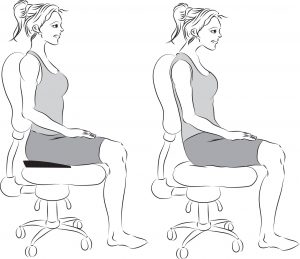
Sitting correctly:
Left image: good. Hips above knees, pelvis not rolling back. Body upright.
Right image: bad. Pelvis rolling back, body slouched, head sticking out.
Image courtesy of straightforwardclinics.com.au.
Here is more of an in-depth explanation, with pictures to illustrate what we mean:
- Sitting causes the most mechanical stress on the spine. Choose a chair that has adequate firmness. The seat should ideally be firm enough that your body is not sinking into it, causing you to slump. Foam cushions of any kind, especially Memory Foam, can cause problems for your body as they do not give enough support to your pelvis and spine.
- The seat should be high enough that your hips are slightly higher than your knees.

Image: good sitting position. Hips above knees. Pelvis not rolling back. Back straight, not slouching. Feet flat on the ground.
- The seat should be flat. Below are some examples of seats that are NOT flat and therefore not ideal for the human body. Unfortunately, most of the typical meeting room chairs aren’t flat! Neither are cinema seats, car seats, office chairs, or most foldable plastic chairs. Old-fashioned dining room chairs are usually flat. There’s a reason Donata went for an antique dining room chair with a flat and firm seat when she was looking for a chair for her room at the office!
-


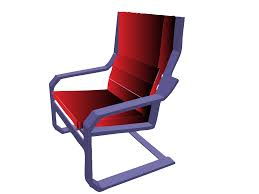


Image: Donata’s chair at the office: flat, firm seat with a seat wedge on it.
- The seat should be slightly tilted forward, not backward. The amount of tilt will vary from person to person. For most people, using a seat wedge will make a big difference. It helps to bring your hips up slightly higher than your knees. You’ll know you have it right, when your pelvis doesn’t roll back and your back doesn’t slouch anymore. If in doubt, talk to your practitioner.
- The backrest should be straight. Straight means upright and flat, not shaped, angled, or rounded. A chair back that curves forward (lumbar supports) pushes the spinal bones forward and out of place (link to blog post 8). A chair back that curves backward (hollow back) allows your back to slump into the chair and pushes your head forward. This pushes spinal bones forward out of place as well. The back of the chair should be flat without curving forward or backward.

Image: Seat angled backward. Bad. Backrest angled backward. Bad.
- A flat, firm seat with a slight forward tilt supports the pelvis and tilts it correctly. A slightly forward pelvic tilt causes the spine to maintain an upright position without muscular effort. It also causes the low back to curve forward naturally, as it should. The result is reduced spinal stress and muscular fatigue. If you feel fatigued in this position, talk to your practitioner. There may be further modifications that need to be made to your seat to suit your body specifically. If your back is aligned properly, you should not need the back rest for support. If you force yourself to lean back and use the back rest, it may create more problems. If in doubt, talk to your practitioner.
- Unfortunately, most chairs are not designed with human bodies in mind. Their seats slouch backward or they are shaped like buckets or bowls. They force you to sit with your knees higher than your hips. Often, a seat wedge can level out the backward slouch.


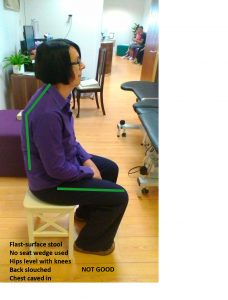
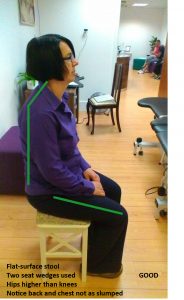
- When sitting and reading, make sure your head and neck are upright. For many of you, this is crucial to your spinal correction. When sitting at a desk or table, prop up your reading material at a 45 degree angle. At the office, it may be necessary to prop up your computer screen -- put it on a screen stand or pop a few books underneath it to bring it up. Your eyes should be level with the middle of the screen. The screen should be at the correct distance from your body: you should just be able to touch it with your arm outstretched.
- Crossing your legs at the knees could aggravate an existing back condition and interfere with the circulation in the lower limbs. If you only find it comfortable to sit with your knees higher than your hips, your knees crossed, or your leg tucked under, it is a sign that your body is really twisted up. These positions may be comfortable right now because sitting like this puts the least amount of strain onto your spine at this point in time. As we correct your body, you will gradually find that these old sitting positions are no longer comfortable and will, in fact, start to feel unnatural or even hurt. Your body heals and sitting correctly will feel more natural. As you sit in a more natural position, your body can heal better.
- If you find it hard to get up and out of a seat, the seat has just messed you up. Soft couches are the classic example for this happening, but it can happen with any seat that is incorrectly angled, or any padded/cushioned seat that doesn’t give enough support to the body.
- In restaurants, chairs are often a better option than booths. The seat padding of the booths is often too soft. It often helps if you take your seat wedge with you to the restaurant.
- Never have your wallet (or anything else, for that matter) in your back pocket. Sitting on your wallet instantly misaligns your pelvis and therefore low back. This increases pulling on your brainstem.
- A soft, overstuffed chair or sofa may feel good when you are sitting in it, but it usually improperly supports your body. A poorly supporting chair causes spinal misalignments that often go unnoticed until after you get out of the chair, when it no longer supports you, and you are left feeling the effects of the spinal misalignments. You won’t breathe as well. You wonder why you are tired at the end of the day. You blame XYZ instead of the fact that your spine is collapsed and your brainstem is being pulled.
- Airline seats are notorious for this, as are lounge chairs. They allow your body to slouch while pushing your head forward. You will be surprised how fresh you can be after a long flight if you fix your seat as recommended.

- Use the same seat principles given above for your car seat. Again this is crucial for your saxpinal correction, so that we don’t have to adjust the same vertebrae over and over again. We don’t want unstable vertebrae being pushed or pulled forward every time you sit in your car. This leads to a waste of our time and your money.
Unfortunately, many car interiors are designed to accommodate the “normal,” modern day postural distortion (overly kyphotic, with C7/T1 and L4/5 slumped forward). Given enough time, they will distort even a healthy spine.
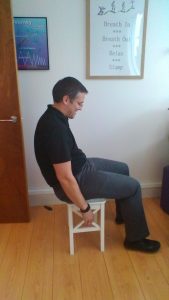

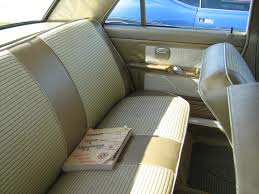
Most car seats can be modified to adequately support you. If they cannot be – it’s time to trade in your car for one that won’t be a health drain!
Again, you want the seat to be either level or, preferably, sloping a bit toward the front. You can use either one or even two foam wedges to accomplish this, if you have the headroom.
Many seat backs are hollow in the thoracic area (to accommodate those slumpers) where they should be flat. If it is, fill in the space with a pillow or towels or rolled up magazine, cardboard, or road atlas.
It is our experience that your participation in these recommendations will be well rewarded. It will speed up your healing process. It will save you time and reduce the cost of care.






